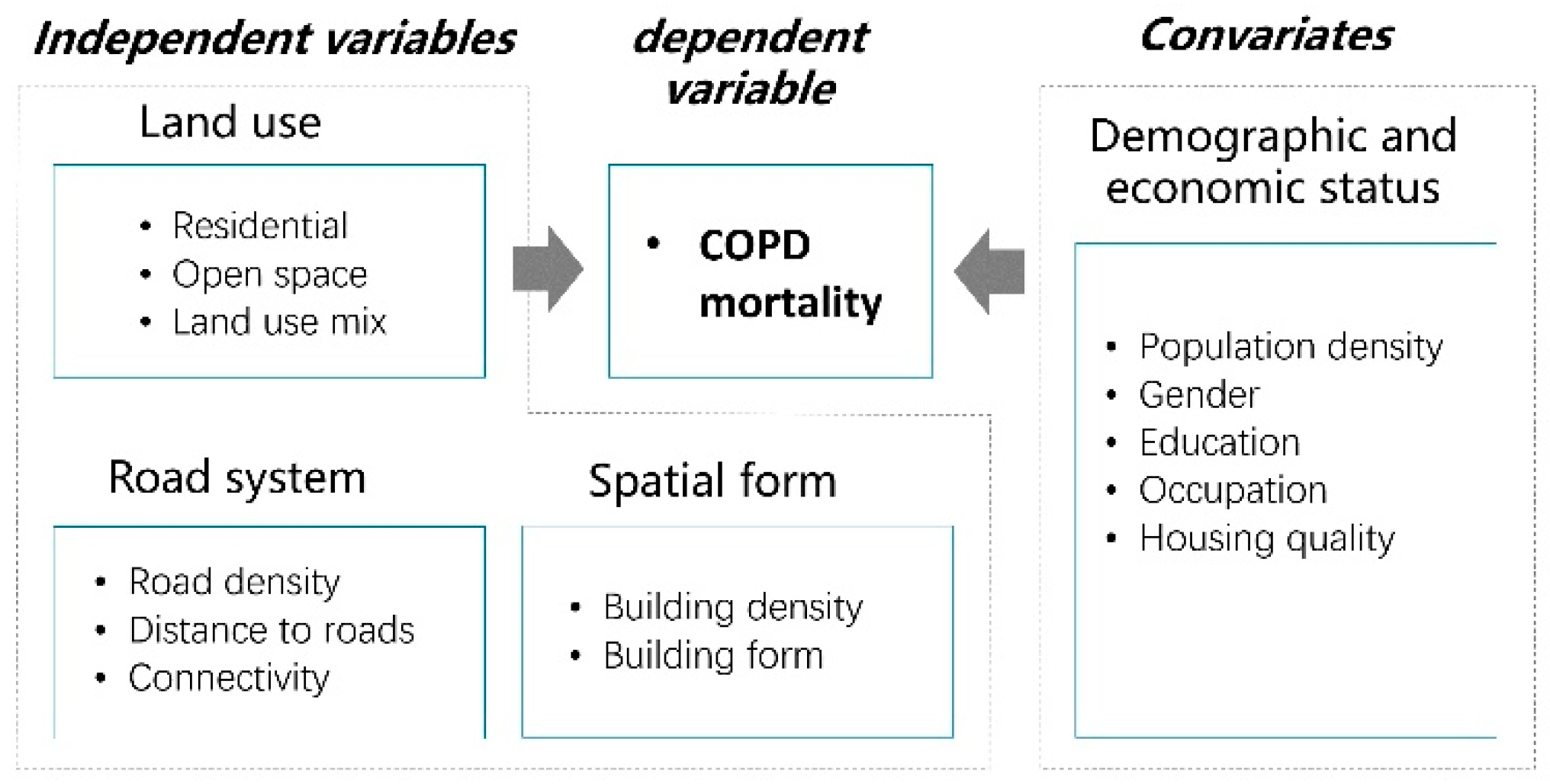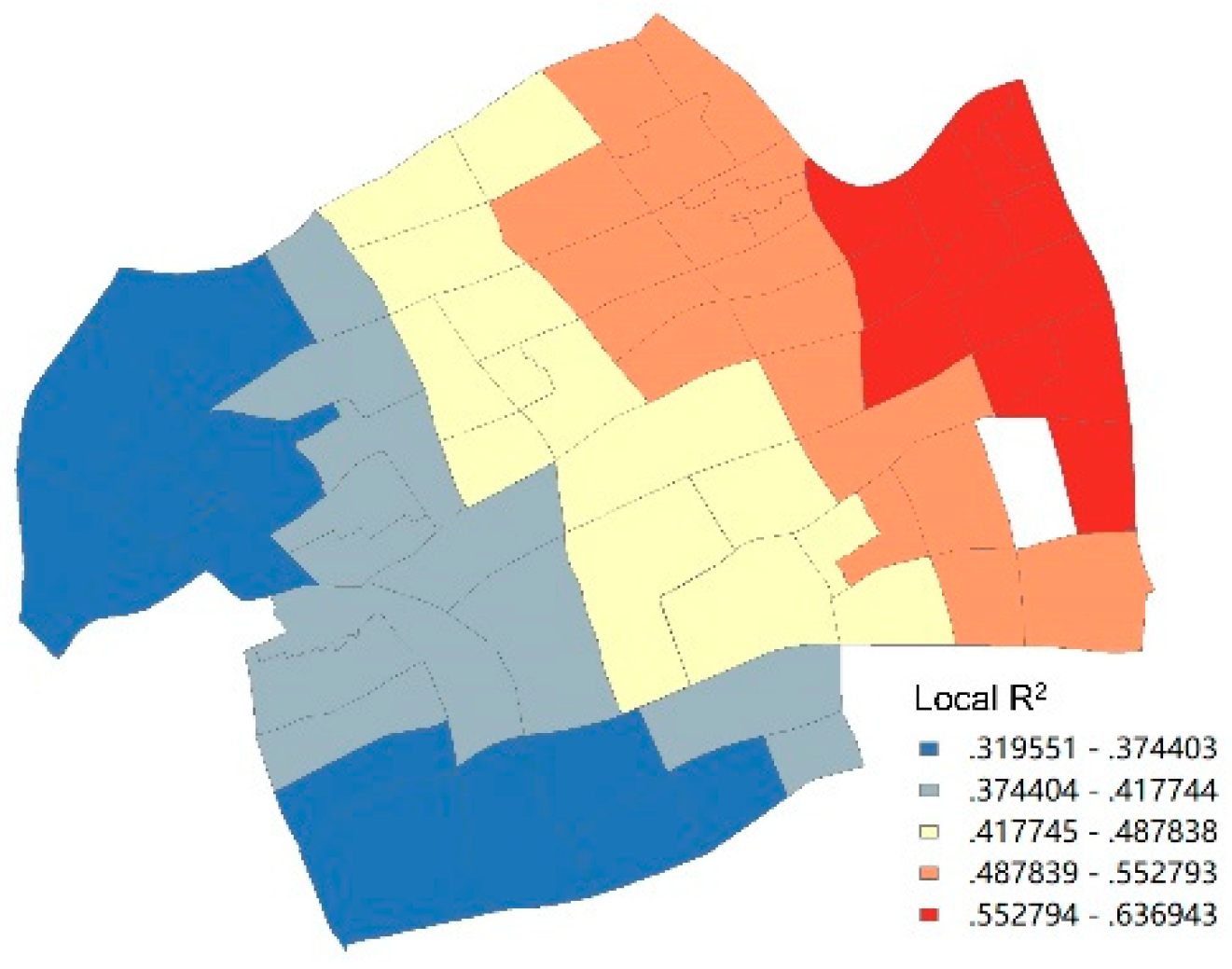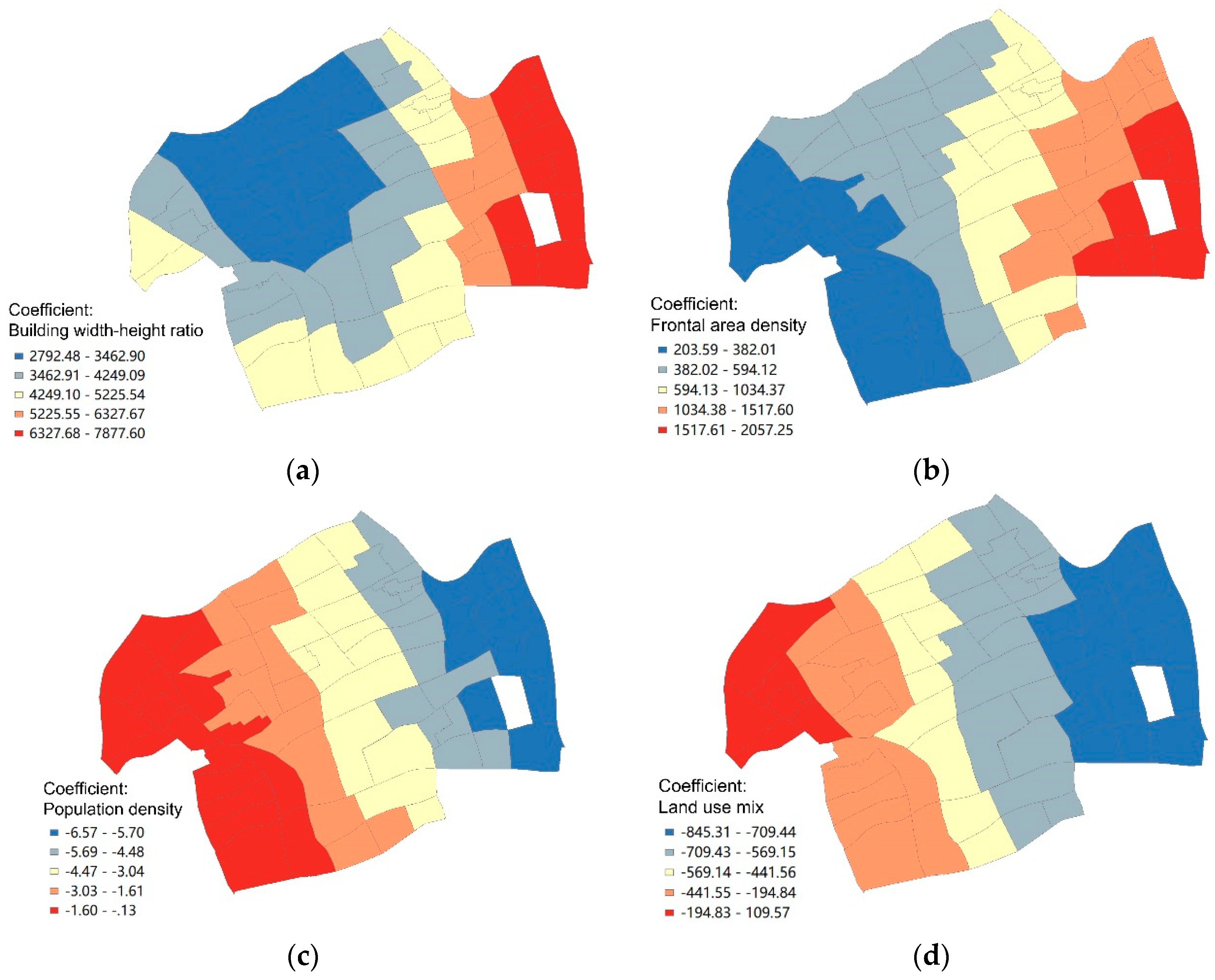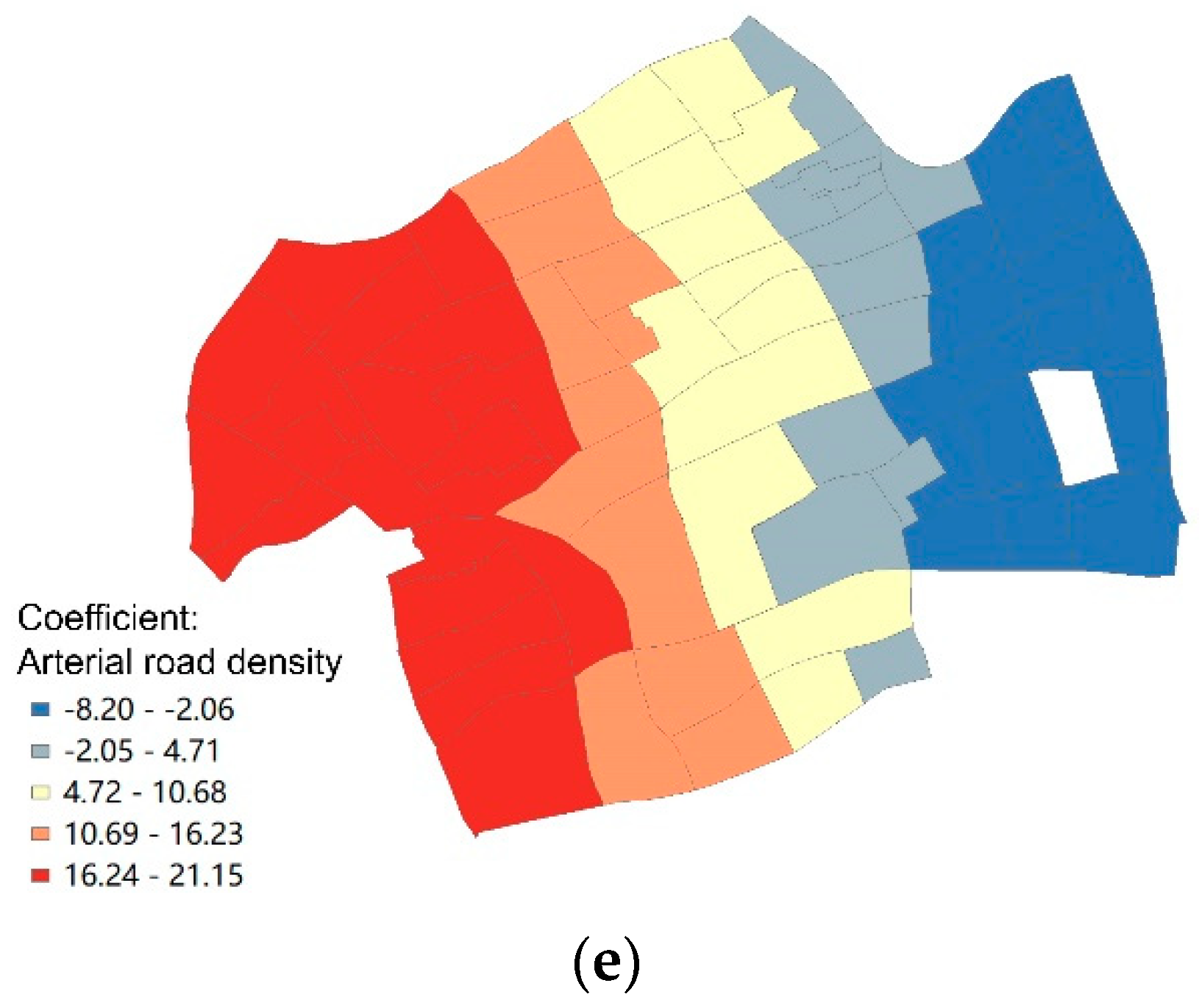Impact of High-Density Urban Built Environment on Chronic Obstructive Pulmonary Disease: A Case Study of Jing’an District, Shanghai
Abstract
1. Introduction
2. Materials and Methods
2.1. Study Area
2.2. Data
2.3. Measures
2.4. Modeling
3. Results
3.1. Spearman’s Rank Correlation Analysis
3.2. GWR
4. Discussion
5. Conclusions
Author Contributions
Funding
Conflicts of Interest
Appendix A
| Categories | Sub-Categories | Variables | Unit | Definition | Potential Impact in Hypotheses |
|---|---|---|---|---|---|
| Land use | Residential | Residential patch density | piece/hm2 | Number of residential land/neighborhood total land area | Higher density increases human exposure to air pollutants |
| Open space | Open space patch density | piece/hm2 | Number of open space land/neighborhood total land area | Higher density increases human exposure to air pollutants | |
| Land use mix | Land use mix | / | Decrease the usage of automobile and thus reduce air pollution | ||
| Road system | Road density | Total road density | km/km2 | Road length/neighborhood total land area | Increase traffic volume and its air pollution |
| Arterial road density | km/km2 | Arterial road length/neighborhood total land area ×1000 | Increase traffic volume and its air pollution | ||
| Distance to roads | Shortest distance to the elevated highway | m | Shortest distance to the elevated highway | The shorter distance implies more human exposure to air pollution | |
| Shortest distance to arterial road | m | Shortest distance to arterial road | The shorter distance implies more human exposure to air pollution | ||
| Connectivity | Intersection density | quantity/hm2 | Intersections number/neighborhood total land area | Increase wind speed and thus decrease the concentration of air pollutants. | |
| Spatial form | Building density | FAR (Floor area ratio) | / | Above-ground building Area/parcel land area | High density increase the concentration of air pollutants |
| Building coverage | % | Building area/parcel land area | High density increase the concentration of air pollutants | ||
| Building form | Building height | / | Standard deviation of building height | High density increase the concentration of air pollutants | |
| Frontal area density | / | ∑ (Frontal area of a building facing to a certain wind direction)/parcel land area | High density decrease wind speed and thus increase the concentration of air pollutants | ||
| Building width-height ratio | / | Building area/frontal Area | High density decrease wind speed and thus increase the concentration of air pollutants | ||
| Demographic and economic status | Population density | Population density | persons/hm2 | Total population/neighborhood total land area | Affect the morbidity and mortality |
| Gender | Female ratio | % | Women/total population | Affect the morbidity and mortality | |
| Education | High education rate | % | Bachelor degree or above/total | Life style and knowledge affect the morbidity and mortality | |
| Occupation | Employment in the secondary industry | % | Production, transportation equipment operators/total employment | Work exposure increases the mortality and mortality | |
| Housing quality | Housing area below 30 m2 | % | Average per unit living area less than 30 m2 | Low housing quality increases the mortality and mortality |


References
- The Top 10 Causes of Death. Available online: https://www.who.int/news-room/fact-sheets/detail/the-top-10-causes-of-death (accessed on 8 December 2019).
- Transcript of Press Conference on 31 July 2019. Available online: http://www.nhc.gov.cn/xcs/s7847/201907/0d95adec49f84810a6d45a0a1e997d67.shtml (accessed on 8 December 2019).
- Global Initiative for Chronic Obstructive Lung Disease, Inc. Global Strategy for the Diagnosis, Management, and Prevention of Chronic Obstructive Pulmonary Disease 2019 Report; Global Initiative for Chronic Obstructive Lung Disease, Inc.: Fontana, WI, USA, 2019. [Google Scholar]
- Chronic Obstructive Pulmonary Disease (COPD). Available online: https://www.who.int/news-room/fact-sheets/detail/chronic-obstructive-pulmonary-disease-(COPD) (accessed on 8 December 2019).
- Bentayeb, M.; Simoni, M.; Baiz, N.; Norback, D.; Baldacci, S.; Maio, S.; Viegi, G.; Annesimaesano, I. Adverse respiratory effects of outdoor air pollution in the elderly. Int. J. Tuberc. Lung Dis. 2012, 16, 1149–1161. [Google Scholar] [CrossRef]
- Qian, Y.; Han, M.; Jin, W.; Cai, R.; Fang, B.; Yu, H.; Qian, N.; Wang, C. Association between ambient air pollution and COPD mortality in Shanghai. J. Environ. Occup. Med. 2015, 32, 1093–1097. [Google Scholar]
- Ju, J.; Ge, M.; Jia, Q.; Yang, H. Relationship between the mortality of chronic obstructive pulmonary disease and the air pollution in Suzhou. J. Clin. Pulm. Med. 2012, 17, 2136–2138. [Google Scholar]
- Van den Berg, M.E.; Stricker, B.H.; Brusselle, G.G.; Lahousse, L. Chronic obstructive pulmonary disease and sudden cardiac death: A systematic review. Trends Cardiovasc. Med. 2016, 26, 606–613. [Google Scholar] [CrossRef] [PubMed]
- Yao, L. Common causes of chronic obstructive pulmonary disease and risk factors for death. Med. Equip. 2019, 32, 108–109. [Google Scholar]
- Rothnie, K.J.; Yan, R.; Smeeth, L.; Quint, J.K. Risk of myocardial infarction (MI) and death following MI in people with chronic obstructive pulmonary disease (COPD): A systematic review and meta-analysis. BMJ Open 2015, 5, e007824. [Google Scholar] [CrossRef] [PubMed]
- Putcha, N.; Drummond, M.B.; Connett, J.E.; Scanlon, P.D.; Tashkin, D.P.; Hansel, N.N.; Wise, R.A. Chronic productive cough is associated with death in smokers with early COPD. J. Chronic Obstr. Pulm. Dis. 2014, 11, 451–458. [Google Scholar] [CrossRef] [PubMed]
- Zhang, D.; Zou, X.; Xin, D.; Deng, Q. Risk factors of death in 88 cases with chronic obstructive pulmonary disease. Guangdong Med. 2007, 961–963. [Google Scholar] [CrossRef]
- Schamberger, A.C.; Mise, N.; Meiners, S.; Eickelberg, O. Epigenetic mechanisms in COPD: Implications for pathogenesis and drug discovery. Expert Opin. Drug Discov. 2014, 9, 609–628. [Google Scholar] [CrossRef]
- Xu, F.; Liang, Y.; Shen, H.; Xu, Y. Years of potential life 10st of chronic obstructive pulmonary diseases among residents in Nanjing from 1997 to 2005. Chin. J. Epidemiol. 2007, 18, 203–204. [Google Scholar]
- Sai, X.; He, Y.; Wang, B.; Meng, D.; Xing, Q.; Xiao, D.; Wang, Y.; Yan, Y. An 18-year follow up study on the risk factors of deaths regarding chronic obstructive pulmonary disease in Xi’an, China. Chin. J. Epidemiol. 2006, 27, 765–768. [Google Scholar]
- Pope, C.A.; Bates, D.V.; Raizenne, M.E. Health effects of particulate air pollution: Time for reassessment? Environ. Health Perspect. 1995, 103, 472–480. [Google Scholar] [CrossRef] [PubMed]
- Dockery, D.W.; Pope, C.A.; Xu, X.; Spengler, J.D.; Ware, J.H.; Fay, M.E.; Ferris, B.G.; Speizer, F.E. An association between air pollution and mortality in six U.S. Cities. N. Engl. J. Med. 1993, 329, 1753. [Google Scholar] [CrossRef] [PubMed]
- Perdue, W.C.; Stone, L.A.; Gostin, L.O. The built environment and its relationship to the public’s health: The legal framework. Am. J. Public Health 2003, 93, 1390–1394. [Google Scholar] [CrossRef] [PubMed]
- Blanco, I.; Diego, I.; Bueno, P.; Fernández, E.; Casas-Maldonado, F.; Esquinas, C.; Soriano, J.B.; Miravitlles, M. Geographical distribution of COPD prevalence in the Americas. COPD 2018, 15, 317–325. [Google Scholar] [CrossRef]
- Raju, S.; Keet, C.A.; Paulin, L.M.; Matsui, E.C.; Peng, R.D.; Hansel, N.N.; McCormack, M.C. Rural residence and poverty are independent risk factors for COPD in the United States. Am. J. Respir. Crit. Care Med. 2019, 199, 961–969. [Google Scholar] [CrossRef]
- Halvorsen, T.; Martinussen, P.E. The geography of chronic obstructive pulmonary disease: A population-based study of Norway. Soc. Sci. Med. 2014, 111, 25–34. [Google Scholar] [CrossRef]
- Wang, L.; Liao, S.; Zhao, X. Exploration of approaches and factors of healthy city planning. Urban Plan. Int. 2016, 31, 4–9. [Google Scholar] [CrossRef]
- Zou, B.; Xu, S.; Zhang, J. Spactial variation analysis of urban air pollution using gis: A land use perspective. Geomat. Inf. Sci. Wuhan Univ. 2017, 42, 216–222. [Google Scholar]
- Ko, F.W.; Hui, D.S. Air pollution and chronic obstructive pulmonary disease. Respirology 2012, 17, 395–401. [Google Scholar] [CrossRef]
- Maurizio, M.; Claudio, N.; Matteo, V.; Carmela, P.; Pasquale, A. Pedestrians in traffic environments: Ultrafine particle respiratory doses. Public Health 2017, 14, 288. [Google Scholar]
- Aziz, A.; Bajwa, I.U. Minimizing human health effects of urban air pollution through quantification and control of motor vehicular carbon monoxide (co) in Lahore. Environ. Monit. Assess. 2007, 135, 459–464. [Google Scholar] [CrossRef] [PubMed]
- Schikowski, T.; Sugiri, D.; Ranft, U.; Gehring, U.; Heinrich, J.; Wichmann, H.; Krämer, U. Long-term air pollution exposure and living close to busy roads are associated with COPD in women. Respir. Res. 2005, 6, 1–10. [Google Scholar] [CrossRef] [PubMed]
- Tiwary, A.; Robins, A.; Namdeo, A.; Bell, M. Air flow and concentration fields at urban road intersections for improved understanding of personal exposure. Environ. Int. 2011, 37, 1005–1018. [Google Scholar] [CrossRef] [PubMed]
- Qiu, Q.; Wang, L. To research for street geometry structure planning based on polluting mechanism in street canyon. Urban Stud. 2007, 14, 78–82. [Google Scholar]
- Aliya, B.; Zhen, J.; Sun, Q.; Kahaer, Z. Pollution characteristics of PM2.5 and PM10 in forest belts along expressway in Urumqi. Environ. Sci. Technol. 2019, 42, 103–108. [Google Scholar]
- Ma, H.; Tan, H.; Hu, T. Research of vertical distribution characteristics of PM2.5 surrounding a roadside building. Build. Energy Environ. 2016, 35, 27–31. [Google Scholar]
- Zhao, X.; Fan, Y.; Si, P.; Zhao, S.; Gou, Z. Pollution characteristics of indoor and outdoor particulate of buildings. J. Environ. Eng. Technol. 2016, 6, 223–228. [Google Scholar]
- Li, S.; Shi, T.; Zhou, S.; Gong, J.; Zhu, L.; Zhou, Y. Diffusion effects of atmospheric pollutants on the three dimensional landscape pattern of urban block. J. Shenyang Jianzhu Univ. (Nat. Sci.) 2016, 32, 1111–1121. [Google Scholar]
- Sun, S.; Gu, R.; Zhang, J. Inhalable particulate matter (PM10) related to different green cover percentage and greenbelt types in Beijing. Chin. Landsc. Archit. 2004, 77–79. [Google Scholar] [CrossRef]
- Zhao, Z.; Wang, Z.; Zhang, Y.; Zhang, S.; Wang, Y. Monitoring and analysis on the distribution of suspended particles near ground level in urban by plants leaves. Ecol. Environ. 2008, 17, 980–984. [Google Scholar]
- Lou, C.; Liu, H.; Li, Y.; Li, Y. Research on the response of air particles (PM2.5, PM10) to landscape structure: A review. Acta Ecol. Sin. 2016, 36, 6719–6729. [Google Scholar]
- Li, S.; Zhu, L.; Shi, T.; Wang, W. The counter measures of urban street planning based on the pollution prevention of inhalant particle. Urban Dev. Stud. 2014, 42–45. [Google Scholar] [CrossRef]
- Chan, A.T.; Au, W.T.W.; So, E.S.P. Strategic guidelines for street canyon geometry to achieve sustainable street air quality—Part II: Multiple canopies and canyons. Atmos. Environ. 2003, 37, 2761–2772. [Google Scholar] [CrossRef]
- Depaul, F.T. A study of pollutant dispersion in an urban street canyon. Atmos. Environ. 1984, 19, 555–559. [Google Scholar] [CrossRef]
- Yin, J.; Zhan, Q. The relationship between ventilation and urban morphology based on the method of morphology—Taking Wuhan as an example. Environ. Prot. 2016, 44, 59–63. [Google Scholar]
- Shen, J.; Qiu, X.; He, Y.; Zeng, Y.; Li, M. Study on comparison of vector/raster calculation model of frontal area density of urban buildings. J. Geogr. Info. Sci. 2017, 19, 1433–1441. [Google Scholar]
- Rabe, K.F.; Watz, H. Chronic obstructive pulmonary disease. Lancet 2017, 389, 1931–1940. [Google Scholar] [CrossRef]
- Spruit, M.; Pitta, F.; Mcauley, E.; Zuwallack, R.; Nici, L. Pulmonary rehabilitation and physical activity in patients with chronic obstructive pulmonary disease. Am. J. Respir. Crit. Care Med. 2015, 192, 924–933. [Google Scholar] [CrossRef]
- Beeh, K.M.; Watz, H.; Puente-Maestu, L.; de Teresa, L.; Jarreta, D.; Caracta, C.; Garcia Gil, E.; Magnussen, H. Aclidinium improves exercise endurance, dyspnea, lung hyperinflation, and physical activity in patients with COPD: A randomized, placebo-controlled, crossover trial. BMC Pulm. Med. 2014, 14, 209. [Google Scholar] [CrossRef]
- Watz, H.; Mailänder, C.; Baier, M.; Kirsten, A. Effects of indacaterol/glycopyrronium (qva149) on lung hyperinflation and physical activity in patients with moderate to severe COPD: A randomised, placebo-controlled, crossover study (the move study). BMC Pulm. Med. 2016, 16, 95. [Google Scholar] [CrossRef] [PubMed]
- Watz, H.; Krippner, F.; Kirsten, A.; Magnussen, H.; Vogelmeier, C. Indacaterol improves lung hyperinflation and physical activity in patients with moderate chronic obstructive pulmonary disease—A randomized, multicenter, double-blind, placebo-controlled study. BMC Pulm. Med. 2014, 14, 158. [Google Scholar] [CrossRef] [PubMed]
- Wai, J.; Yuan, T.; Cheng, D. Minimum amount of physical activity for reduced mortality and extended life expectancy: A prospective cohort study minimum amount of physical activity for reduced mortality and extended life expectancy: A prospective cohort study. Lancet 2016, 378, 1244–1253. [Google Scholar]
- Demeyer, H.; Burtin, C.; Hornikx, M.; Camillo, C.A.; Van, R.H.; Langer, D.; Janssens, W.; Troosters, T. The minimal important difference in physical activity in patients with COPD. PLoS ONE 2016, 11, e0154587. [Google Scholar] [CrossRef] [PubMed]
- De Souto Araujo, Z.T.; de Miranda Silva Nogueira, P.A.; Cabral, E.E.; de Paula Dos Santos, L.; da Silva, I.S.; Ferreira, G.M. Effectiveness of low-intensity aquatic exercise on COPD: A randomized clinical trial. Respir. Med. 2012, 106, 1535–1543. [Google Scholar] [CrossRef] [PubMed]
- Belfer, M.H. The impact of exercise on activities of daily living and quality of life: A primary care physician’s perspective. J. Chronic Obstr. Pulm. Dis. 2007, 4, 289–291. [Google Scholar] [CrossRef] [PubMed]
- Guo, L.; Yang, W.; Bi, Y. Analysis of the impact of the built environment on the travel characteristics of residents—A case study of 8 blocks in Wuhan city. In Proceedings of the Annual Urban Traffic Planning Conference, Shenzhen, China, 15–16 April 2016. [Google Scholar]
- Yang, D.; Liu, Z. The influence of built environment on senior activities: Daily shopping activity analysis. Planners 2015, 31, 101–105. [Google Scholar]
- Tamura, K.; Puett, R.C.; Hart, J.E.; Starnes, H.A.; Laden, F.; Troped, P.J. Spatial clustering of physical activity and obesity in relation to built environment factors among older women in three U.S. States. BMC Public Health 2014, 14, 1322. [Google Scholar] [CrossRef]
- Ana, M.; Vania, C.; Sara, V.; Carlos, S. Assessing and monitoring urban resilience using COPD in Porto. Sci. Total Environ. 2012, 414, 113–119. [Google Scholar]
- Moreno, A.; Espinoza-Navarro, O. Copd in non-smoking elderly men at sea level and high altitude: Comparing anthropometric characteristics and physiological responses. Int. J. Morphol. 2013, 31, 618–622. [Google Scholar] [CrossRef][Green Version]
- Fu, G.; Zhang, X.; Liu, H. Study on the correlation between temperature and chronic obstructive pulmonary disease in Shijiazhuang, China—Retrospective cohort. J. Geosci. Environ. Prot. 2017, 5, 23–31. [Google Scholar] [CrossRef]
- Aschan-Leygonie, C.; Baudet-Michel, S.; Mathian, H.; Sanders, L. Respiratory health inequalities between cities: A geographical approach. Environ. Risques Santé 2013, 12, 118–128. [Google Scholar]
- Shanghai Statistical Yearbook. Available online: http://tjj.sh.gov.cn/html/sjfb/201701/1000198.html (accessed on 8 December 2019).
- Liu, W.X.; Gao, Z.; Muhetaer, A.; Halmurat, U. Analysis on risk factors of chronic obstructive pulmonary disease based on epidemiological survey in different areas of China. Med. Recapitul. 2013, 19, 1243–1246. [Google Scholar]
- Cho, K.H.; Nam, C.M.; Lee, E.J.; Choi, Y.; Yoo, K.B.; Lee, S.H.; Park, E.C. Effects of individual and neighborhood socioeconomic status on the risk of all-cause mortality in chronic obstructive pulmonary disease: A nationwide population-based cohort study, 2002–2013. Respir. Med. 2016, 114, 9–17. [Google Scholar] [CrossRef]
- Zhang, Q.; Huang, C.; Gong, Z.; Jia, G. Analysis of correlation relationship of population, economy, energy consumption and atmospheric environmental pollution in Berjing-Tianjin-Hebei region. Guangzhou Chem. Ind. 2017, 45, 138–140. [Google Scholar]
- Yan, W. Sociological perspectives on air pollution: A cross-national analysis of social determinants of fine particulate matter (PM2.5). Sociol. Rev. China 2015, 3, 53–67. [Google Scholar]
- Chen, J.; Schooling, C.M.; Johnston, J.M.; Hedley, A.J.; McGhee, S.M. How does socioeconomic development affect COPD mortality? An age-period-cohort analysis from a recently transitioned population in China. PLoS ONE 2011, 6, e24348. [Google Scholar] [CrossRef][Green Version]
- Byrne, A.L.; Marais, B.J.; Mitnick, C.D.; Lecca, L.; Marks, G.B. Risk factors for and origins of COPD. Lancet 2015, 1723–1724. [Google Scholar] [CrossRef]
- Wang, C.; Xu, J.; Yang, L.; Xu, Y.; Zhang, X.; Bai, C.; Kang, J.; Ran, P.; Shen, H.; Wen, F.; et al. Prevalence and risk factors of chronic obstructive pulmonary disease in China (the China pulmonary health [cph] study): A national cross-sectional study. Lancet 2018, 391, 1706–1717. [Google Scholar] [CrossRef]
- Liao, X.; Peng, D.; Wang, W.; Lei, Y.; Luo, F.; Yang, Z.; Su, Q.; Zou, C. Prevalence of COPD and its influential factors in rural urban community, Chengdu. Mod. Prev. Med. 2015, 42, 1543–1546. [Google Scholar]
- Mccormack, G.R.; Shiell, A. In search of causality: A systematic review of the relationship between the built environment and physical activity among adults. Int. J. Behav. Nutr. Phys. Act. 2011, 8, 125. [Google Scholar] [CrossRef] [PubMed]
- Burian, S.J.; Velugubantla, S.P.; Brown, M.J. Morphological analyses using 3d building databases: Salt Lake City, Utah. Analyst 2002, 4, 55–56. [Google Scholar]
- Liu, C.; Shen, Q. An empirical analysis of the influence of urban form on household travel and energy consumption. Comput. Environ. Urban Syst. 2011, 35, 347–357. [Google Scholar] [CrossRef]
- Hong, J.; Shen, Q. Residential density and transportation emissions: Examining the connection by addressing spatial autocorrelation and self-selection. Transp. Res. Part D 2013, 22, 75–79. [Google Scholar] [CrossRef]





| Categories | Sub-Categories | Variables | Correlation Coefficient | Sig. (Double Side) |
|---|---|---|---|---|
| Land use | Residential | Residential patch density | −0.118 | 0.331 |
| Open space | Open space patch density | −0.055 | 0.648 | |
| Land use mix | Land use mix | −0.247 * | 0.040 | |
| Road systems | Road density | Total road density | 0.482 ** | 0.000 |
| Arterial road density | 0.535 ** | 0.000 | ||
| Distance to roads | Shortest distance to the elevated highway | 0.025 | 0.838 | |
| Shortest distance to arterial road | 0.056 | 0.643 | ||
| Connectivity | Intersection density | −0.126 | 0.298 | |
| Spatial form | Building density | FAR (Floor area ratio) | −0.111 | 0.361 |
| Building coverage | −0.073 | 0.547 | ||
| Building form | Building height | −0.134 | 0.267 | |
| Frontal area density | −0.460 ** | 0.000 | ||
| Building width-height ratio | 0.408 ** | 0.000 | ||
| Demographic and economic status | Population density | Population density | −0.540 ** | 0.000 |
| Gender | Female ratio | −0.121 | 0.317 | |
| Education | High education rate | −0.143 | 0.237 | |
| Occupation | Employment in the secondary industry | 0.122 | 0.315 | |
| Housing quality | Housing area below 30 m2 | 0.034 | 0.777 |
© 2019 by the authors. Licensee MDPI, Basel, Switzerland. This article is an open access article distributed under the terms and conditions of the Creative Commons Attribution (CC BY) license (http://creativecommons.org/licenses/by/4.0/).
Share and Cite
Wang, L.; Chen, R.; Sun, W.; Yang, X.; Li, X. Impact of High-Density Urban Built Environment on Chronic Obstructive Pulmonary Disease: A Case Study of Jing’an District, Shanghai. Int. J. Environ. Res. Public Health 2020, 17, 252. https://doi.org/10.3390/ijerph17010252
Wang L, Chen R, Sun W, Yang X, Li X. Impact of High-Density Urban Built Environment on Chronic Obstructive Pulmonary Disease: A Case Study of Jing’an District, Shanghai. International Journal of Environmental Research and Public Health. 2020; 17(1):252. https://doi.org/10.3390/ijerph17010252
Chicago/Turabian StyleWang, Lan, Rui Chen, Wenyao Sun, Xiaoming Yang, and Xinhu Li. 2020. "Impact of High-Density Urban Built Environment on Chronic Obstructive Pulmonary Disease: A Case Study of Jing’an District, Shanghai" International Journal of Environmental Research and Public Health 17, no. 1: 252. https://doi.org/10.3390/ijerph17010252
APA StyleWang, L., Chen, R., Sun, W., Yang, X., & Li, X. (2020). Impact of High-Density Urban Built Environment on Chronic Obstructive Pulmonary Disease: A Case Study of Jing’an District, Shanghai. International Journal of Environmental Research and Public Health, 17(1), 252. https://doi.org/10.3390/ijerph17010252





